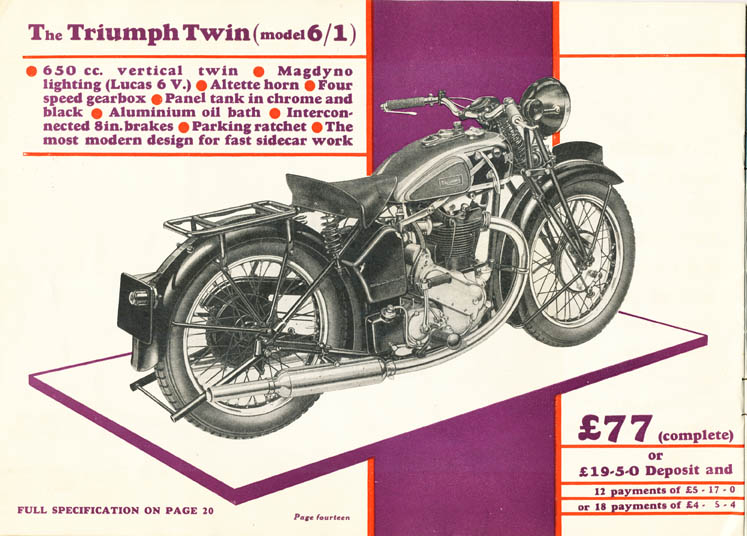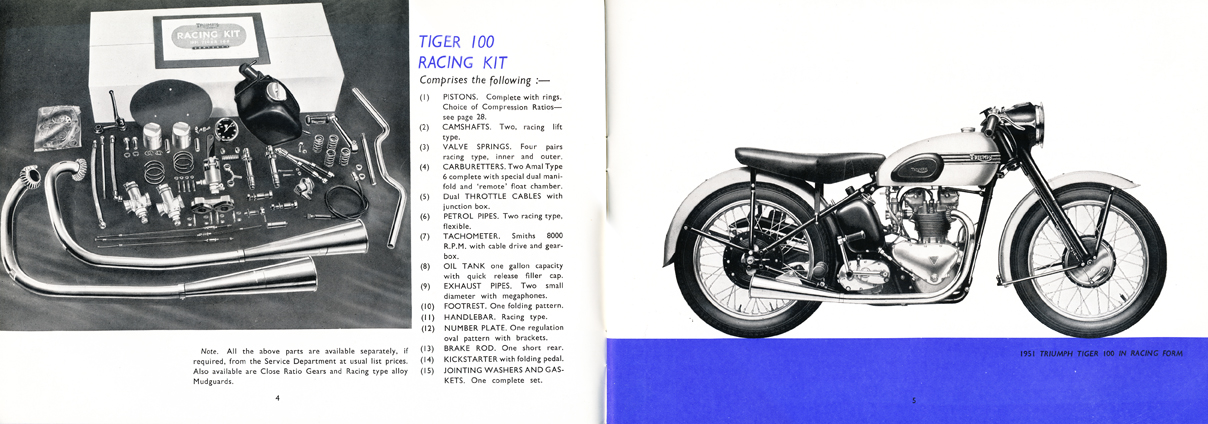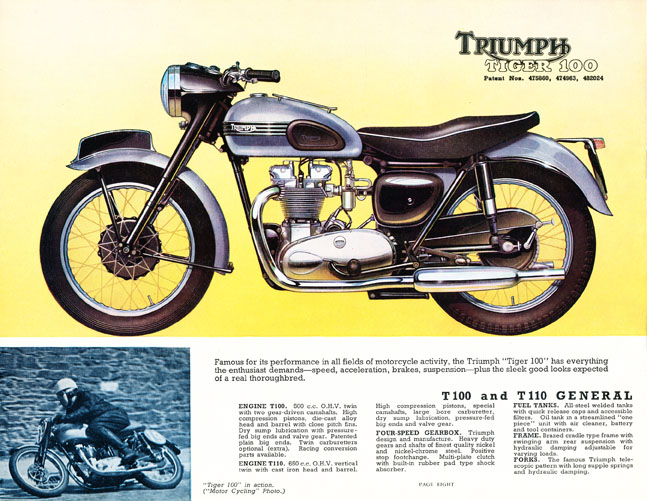A history of Triumph’s Tiger 100
First published in the Antique Motorcycle (the magazine of the Antique Motorcycle Club of America) in my Pulp Non-Fiction column, a look at Triumph’s T100 model as seen in the literature of the day.
Triumph Twin of 1935.
Let’s take a close look at the Tiger 100, a model powered by a parallel twin engine produced by the Triumph Engineering Co. Ltd. I won’t go into detail about the start of the Triumph company, preferring to tuck into the story in the late 1920s with the introduction of two men instrumental in the evolution of the British motorcycle, Val Page and Edward Turner. Page was chief designer at Ariel when he met Turner in 1928. Ariel boss Jack Sangster had hired Turner to develop a square four engine; the basis for the long-running Ariel Square Four.
While testing his square four engine at Ariel, Turner made up a 360-degree twin crankshaft, and ran this uncoupled in the back half of his four, an arrangement otherwise known as a parallel twin. Turner said in the Ivor Davies’ book It’s a Triumph that Page paid particular attention to the characteristics of his ‘experimental’ twin. Whether Turner’s work was an influence or not, in 1932 when Page, himself a keen engineer and designer of rather striking motorcycles, left Ariel for employment at Triumph he soon had a running 650cc vertical twin motorcycle. Introduced in 1933 at the Olympia Show, the Model 6/1 was part of Triumph’s 1934 sales program.
I have a 1935 Triumph brochure, and the ad copy for the 6/1 twin states: “This modern power unit of new design has many features which are entirely original. The cylinders, while cast ‘en bloc’ are vertical, side by side, one cylinder each side of the centre of the crankcase (having a firing angle of 360 degrees), and have adequate air passages between them. They maintain the characteristics of two single cylinders, having separate detachable single port heads. The valve gear (two valves per cylinder) is operated by push rods fully enclosed and working between the two cylinder barrels.”
Page’s twin wasn’t the first for Triumph. In 1913, the company built an experimental 600cc side-valve vertical twin that featured a horizontally split crankcase. There isn’t much other information about the engine, and the war intervened in its development.
More than just the 6/1 twin, Page designed a range of Triumph singles with 250, 350 and 500cc sidevalve and overhead valve configurations. None of these Triumphs were inexpensive to produce, and by the mid 1930s the company was facing financial turmoil. Ariel boss Jack Sangster saw an opportunity to purchase the foundering Triumph works, and he moved Turner over from Ariel. Page had already jumped ship, taking his considerable design talents to rival maker BSA.
In 1936 at Triumph, Turner became chief designer and managing director. His first exercise was to take three examples of single-cylinder machines, originally designed by Page, and dress them up with a sportier image. He created the 250cc Tiger 70, 350cc Tiger 80 and 500cc Tiger 90, all with polished alloy primary cases, chrome plated gas tanks with silver-sheen painted side and top panels and purposeful high-level exhaust systems. The frames were rigid, and front suspension was supplied by a set of girder forks. These singles proved quick sellers, but Turner had something else in mind for Triumph, and it was an entirely new twin.
Turner drew a twin-cylinder engine, and dubbed it the Speed Twin. Featuring a vertically split crankcase housing a single, central flywheel, the 498cc engine became one of the most popular motorcycle power plants of all time. Crankpins are “in line”, allowing both pistons to rise and fall simultaneously. The cylinders fire alternately with power impulses spaced evenly at 360 degrees. Early Speed Twin motors are fitted with a six-stud cast iron barrel and cylinder head, with separate alloy boxes housing both the rockers and valve adjusters. Camshafts are situated high in the crankcase, gear driven through an idler gear by the right side of the crankshaft. Separate pushrod tubes run fore and aft of the cylinders.
In 1937 the twin-cylinder engine looked very similar to what would have been a conventional twin-port single-cylinder unit, without being much wider or heavier. The twin made only four more horsepower than Triumph’s 500cc single, 28 h.p. compared to 24 h.p. But the power delivery of the twin rivaled that of the single; it was much more refined, with better torque and pull from low speeds, plus it was easier to start.
Turner dropped his parallel-twin engine into the heavyweight Tiger 90 single-cylinder cycle parts sprayed in Amaranth Red and the Speed Twin was first shown in 1937. It was available to the public in 1938, and sold very well. There was some trouble with the original six-stud barrel to crankcase fixing configuration, and in 1939, eight studs were introduced. Bigger news for 1939, however, was the addition of a sporting stablemate to the Speed Twin in the form of the Tiger 100.
Triumph Tiger 100 of 1939.
Inside the 1939 Triumph brochure, the maker states: “Triumph have long held the view that for sports use the O.H.V. single of over 350 c.c. is an obsolete type, and the overwhelming endorsement of this view by the serious motor cyclist during 1938 has encouraged us to produce the multi-cylinder “TIGER 100” to replace the “TIGER 90” single. This super-tuned brother of the successful “SPEED TWIN” is a most impressive machine both in performance and appearance and will undoubtedly become a firm favourite.”
Tiger 100 motorcycles made approximately seven more horsepower than the Speed Twin, and were fitted with 8:1 high compression alloy slipper pistons, with all internal moving parts polished. Providing sparks and electrical current was a Lucas magdyno sitting on a platform behind the cylinders. A single 1” bore Amal carburetor fed fuel and air through a new manifold designed to increase flow. Stock head and barrels are of cast iron, but racing enthusiasts could order an aluminum-bronze cylinder head. Almost race-ready from the factory, the machine was equipped with mufflers of the open megaphone-type, but with quickly detachable ends that incorporated baffles and tail pipe.
Triumph Tiger 100 of 1948.
In my 1948 Triumph brochure, the Tiger 100 has been updated with telescopic forks, and the new sprung hub an extra option. Gone, however, are the sharp-looking megaphone-type mufflers, and the magdyno has changed to separate magneto at the back and dynamo at the front of the engine. Ad copy states: “The TRIUMPH “TIGER 100” is an ultra high performance sports machine with a specially tuned engine capable of completely satisfying the desires of all who wish to travel fast and far. At the same time it retains that flexibility and smoothness which make it a very pleasant motor cycle when high speeds are not desired.”
Triumph’s Tiger 100 continued in similar specification until 1951, when the motorcycle was fitted with a nacelle-style headlamp and long bench-type seat. Frame is still rigid, with a sprung hub offering the only rear springing action. The motorcycle is a cracking performer, says a 1951 Triumph booklet dubbed Tuning the 1951 Triumph Tiger 100. “(The T100) has always responded well to the efforts of amateur tuners, and has taken a successful part in competitive events in all parts of the world.”
The copy continues: “The 1951 Tiger 100 is a new model incorporating a new engine of advanced design with an aluminum alloy cylinder barrel and head, and many other features calculated to provide enhanced performance. This machine is both lighter and faster than its predecessor, and although it is supplied from the factory to roadster specification only, a special feature is the provision made in its design whereby it can, at a most reasonable cost, readily be converted by the knowledgeable owner from its standard form to racing specification.”
Triumph’s legendary Tiger 100 Racing Kit.
Enter the special Tiger 100 Racing Kit, a package of parts in its own container that could be supplied to an owner on receipt of their engine and frame numbers. The components were available separately, but the Racing Kit came complete with either 8.25:1 or 9.5:1 compression ratio pistons, racing profile camshafts, valve springs, twin Amal Type 6 carbs with remote float and dual throttle cables, Smiths 8,000 rpm tachometer, one gallon oil tank with quick release cap, exhaust pipes with megaphones, footrests, handlebar, number plate, short rear brake rod, folding kickstart lever and set of gaskets.
“Success in racing does not come by chance,” the brochure explains. “It is the result of experience and painstaking preparation both of the man and the machine.” While the T100 booklet dealt in the main with the machine, there were also a few paragraphs about the physical and mental requirements of ‘the Man.’
In a brochure published 24th October 1952 (this would be the 1953 model year) the company produced a Tiger 100 and Tiger 100C. Both still had rigid frames, and the T100C appears to have been prepared from the factory for racing, complete with the dual Amal carbs, high compression pistons and racing cams. Horsepower is rated at 42@7,000 rpm when fitted with a racing exhaust, quite an improvement over the 28 h.p. of the original Speed Twin engine.
Triumph introduced their swingarm frame in 1954, and the Tiger 100 was so fitted. In the 1955 brochure there is just the Tiger 100; no sign of a Tiger 100C (it was a one-year only offering), nor word of the Racing Kit. The T100 is listed in the 1956 brochure, and a new splayed-port twin carburetor head is offered as an extra for the speed enthusiast.
Triumph Tiger T100 of 1955.
Triumph Tiger 100 of 1957.
Triumph moved to unit engine/gearbox construction in 1959, and the Tiger 100 made the change. The last brochure I have is from 1965 and it lists the Tiger 100 and Tiger 100S/S. “A machine with a host of successes in production machine racing and gaining gold medal honours in the International Six Days’ Trial for the past four years, the Tiger 100 has more than proven itself in these tough marathon endurance tests. Produced especially for the sporting rider who demands the ultimate in performance from a 500 c.c. machine,” the copy states.
Triumph Tiger of 1965.
The Tiger 100 motorcycles eventually culminated in the Daytona 500cc machines, which ended production in 1973 – a 34 year run. The name returned to a motorcycle thanks to the new Hinckley Triumph company, which introduced a Tiger in 1993. Years of competitive successes, especially in American flat track, enduro and Daytona races, have ensconced the Tiger 100 firmly in history, and it’s all thanks to Edward Turner’s parallel twin engine.








This Post Has 0 Comments